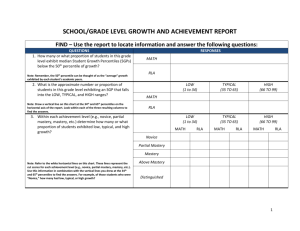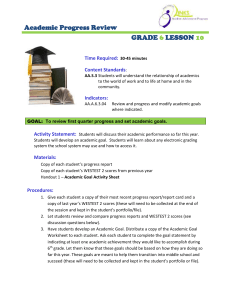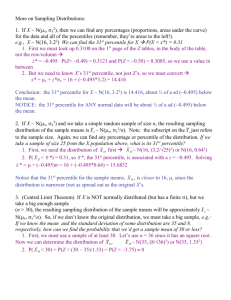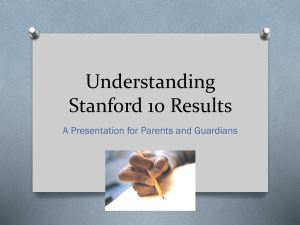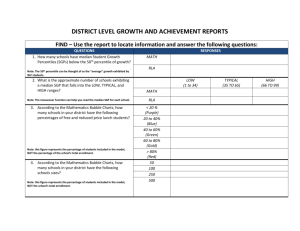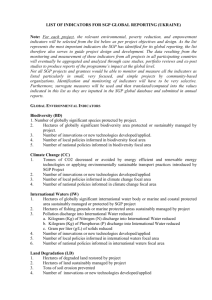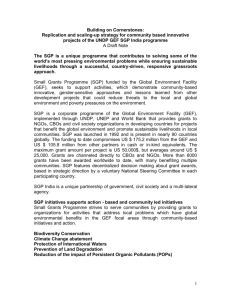INDIVIDUAL STUDENT GROWTH AND ACHIEVEMENT REPORTS
advertisement
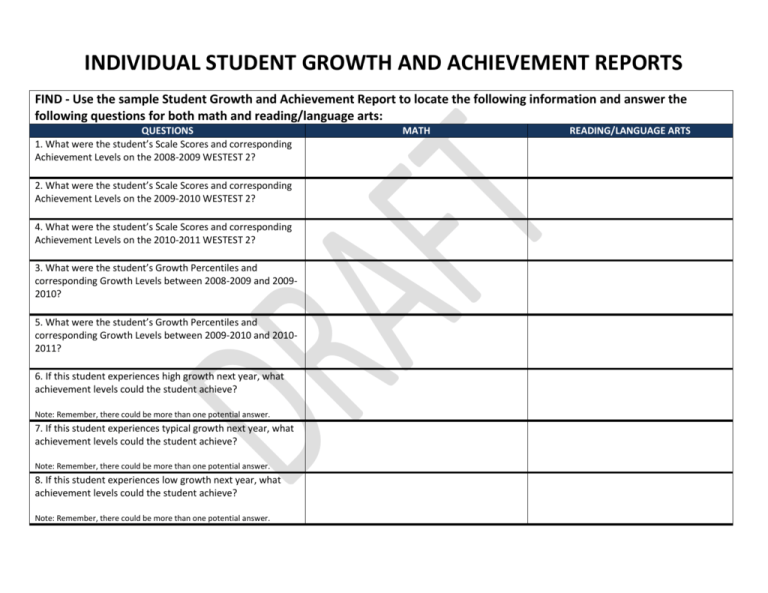
INDIVIDUAL STUDENT GROWTH AND ACHIEVEMENT REPORTS FIND - Use the sample Student Growth and Achievement Report to locate the following information and answer the following questions for both math and reading/language arts: QUESTIONS 1. What were the student’s Scale Scores and corresponding Achievement Levels on the 2008-2009 WESTEST 2? 2. What were the student’s Scale Scores and corresponding Achievement Levels on the 2009-2010 WESTEST 2? 4. What were the student’s Scale Scores and corresponding Achievement Levels on the 2010-2011 WESTEST 2? 3. What were the student’s Growth Percentiles and corresponding Growth Levels between 2008-2009 and 20092010? 5. What were the student’s Growth Percentiles and corresponding Growth Levels between 2009-2010 and 20102011? 6. If this student experiences high growth next year, what achievement levels could the student achieve? Note: Remember, there could be more than one potential answer. 7. If this student experiences typical growth next year, what achievement levels could the student achieve? Note: Remember, there could be more than one potential answer. 8. If this student experiences low growth next year, what achievement levels could the student achieve? Note: Remember, there could be more than one potential answer. MATH READING/LANGUAGE ARTS ANALYZE AND INTERPRET - Use what you have discovered to answer the following questions for both math and reading/language arts: QUESTIONS 1. Based on the student’s Growth Percentile between the 2008-2009 WESTEST 2 and the 2009-2010 WESTEST 2, what percentage of her/his academic peers exhibited greater growth? MATH READING/LANGUAGE ARTS Note: Conversely, what percentage of this student’s academic peers exhibited lower growth? 2. Based on the student’s Growth Percentile between the 2009-2010 WESTEST 2 and the 2020-2011 WESTEST 2, what percentage of her/his academic peers exhibited greater growth? Note: Conversely, what percentage of this student’s academic peers exhibited lower growth? 3. Approximately what Growth Percentile and corresponding Growth Level are necessary for the student to catch up, keep up or fall behind next year? If one of these outcomes is not possible, mark “N/A.” Note: Look at the model’s projection for next year (commonly called the “fan”), and remember that: 1. 2. 3. 4. 5. The bottom of the fan represents 1st percentile growth while the top represents 99th percentile growth. The cut points for low, typical, and high growth are indicated by their colors, so that the top of the red area is the 34th percentile, the top of the white area is the 65th percentile, and so forth. To “keep up” next year, the student must currently be at mastery or higher and be projected to exhibit a growth percentile which will result in her/him staying at or above mastery. To “catch up” next year, the student must currently be below mastery and be projected to exhibit a growth percentile that will result in her/him reaching mastery or higher. To “fall behind” next year, the student must currently be at mastery or higher but be projected to exhibit a growth percentile which will result in her/him falling below mastery. SGP and Growth Level needed to Catch Up SGP and Growth Level needed to Catch Up SGP and Growth Level needed to Keep Up SGP and Growth Level needed to Keep Up SGP and Growth Level needed to Fall Behind SGP and Growth Level needed to Fall Behind 9. Compare the student’s Growth Percentiles and Growth Levels from one year to the next. Briefly describe the differences or similarities you see. Note: Consider the following: 1. What is the difference in the growth percentile? 2. How has the growth level changed? 10. If the student’s Growth Percentiles and Growth Levels from one year to the next are different, what are some factors that might have contributed to these differences? PLAN NEXT STEPS – Now that you know something about this student’s growth over several years and his or her possible growth in the future, where can you go to get more information to answer some important questions regarding this student: RESOURCES/DESCRIPTION Grade Level Growth and Achievement Report: This report, available for both mathematics and reading/language arts for each grade level where growth data are available, illustrates the growth and achievement levels of all students in a given grade within a single school. Current year achievement for each student (scale score and achievement level) is plotted on the vertical axis and observed growth (SGP) on the horizontal axis. Mouseover functionality in the PDF file displays each student’s name as well as their observed SGP, target SGP, scale score, and corresponding achievement level for the most recent academic year. The Individual Right Response Record (IRRR): The IRRR shows a breakdown of individual student performance on WESTEST 2. Teachers, students and parents can identify which CSOs are causing the student the most difficulty. Additionally, the RLA portion of the report provides the student’s Online Writing scores in each of the analytic writing traits of organization, development, sentence structure, word choice/grammar usage and mechanics. Acuity Reports: Teachers have access to several report formats for all Acuity assessments. These reports provide data regarding student achievement at various levels (district, school, classroom and student) regarding overall achievement on a test as a whole to individual items within a test, including distractor analysis. These reports can be used to help teachers identify key strengths and weaknesses in student understanding of concepts recently presented in the classroom. The teachers can then utilize test data, test item analysis, and formative assessment techniques in concert to provide a course correction while continuing to move forward in the curriculum. Acuity reports that are helpful in this process include Assessment Reports, Item Analysis Reports with the embedded distractor analysis, Classroom Matrix Reports and Student Summary Reports. WV Writes Reports: Reports in WV Writes that teachers can use formatively in the classroom range from whole group proficiency reports to individual student summary reports. Teachers can view the proficiency levels of their students’ writing in WV Writes with the Proficiency Summary report. Class reports for teachers include the status of students’ progress on assignments, the students’ level of proficiency on each analytic writing trait, and the students’ progress based on the chronological order of their essay writing. Individual student reports can be generated to show the writing gains of the five analytic traits and the holistic score for each student as they complete essays in WV Writes. QUESTIONS How does this student’s growth compare with other students in the same grade within this school? Upon which standards has the student demonstrated mastery? Which standards have not been mastered? RESPONSE Classroom Assessments aligned to 21st Century WV Content Standards and Objectives: Teacher-created classroom assessments – both formative and summative – can provide information with regard to the knowledge, skills and abilities the student current has and those that the students have yet to learn to help him or her get to the goal of competency. Excel Monitoring Tools (EMTs): These Excel spreadsheets developed by the Office of Assessment and Accountability and available in the File Cabinet on the Office of Assessment and Accountability website can help teachers analyze WESTEST 2 data to focus on areas of weakness that might affect the student’s growth and achievement.
